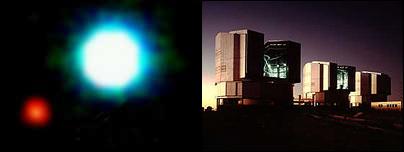The small red dot - an experiment of the Yepun unit to its limits
Avi Blizovsky

Right: the VLT array that includes 4 telescopes with a diameter of 8.2 meters; Left: The new planet and its sun
Direct link to this page: https://www.hayadan.org.il/planet120904.html
An international team of astronomers working in Chile believe they have succeeded in photographing a planet orbiting another star for the first time. The star, known as 2M1207 is 230 light-years away and is much smaller and fainter than our Sun.
In the picture you see a companion to this star, 100 times smaller than it - an image that the technological limits of the Yepun telescope were tested to take. Astronomer Christophe Dumas says: "It's a strange feeling to know that we are probably the first to photograph planets in another solar system."
Benjamin Zuckerman of the University of California, Los Angeles, added: "If the companion of 2M1207 is indeed a planet, it will be the first time that a planet, so far discovered only through its gravitational influence, has been observed near a star or brown dwarf.
Anne Marie Lagrange (Lagrange) from Grenoble Observatory in France, said: "Our discovery represents the first step towards opening a new field in astrophysics: imaging and spectroscopic study of planetary systems."
"Studies of this type will allow astronomers to characterize the physical structure and chemical composition of giant planets and eventually terrestrial planets as well.
The observation was made with the Japan Telescope, part of the Very Large Telescope Array (VLT) operated by the European Southern Observatory (ESO) located at Cro Paranal in the Atacama Desert in Chile.
In April, a European and American team using iPhone discovered a pale red point of light near the brown dwarf 2M1207.
The mass of the star is a few percent of the mass of the Sun and it cannot trigger nuclear fusion reactions in its core to produce energy the way the Sun does. The age of 2M1207 is estimated at about 8 million years. The star is part of the southern star system TW Hydrae. Examining the spectrum of the star showed signs of the existence of water molecules and confirmed that the object must be small and light. The researchers are not XNUMX percent sure that the object is a companion planet, but they believe that further observations will prove it.
The observations will last about a year. Meanwhile, astronomers treat the object as a candidate for a planet.
".
On several occasions in recent years, astronomical photographs have revealed objects that appeared to be planets, but upon further study, none of these candidates were convincing. During the TW Hydrae dwarf survey, the Japan telescope was operated in adaptive optics mode. This means bending the mirror to compensate for the Earth's atmospheric vortices to produce a much sharper image. According to Gael Chauvin from ESO (Gael Chauvin), if the image had been taken without the optical adjustment, the object would not have been seen.
The challenge of viewing a pale light source in real time on the device's screen is unbelievable," says Dumas, who also works at ESO. The series of exposures was made using a variety of filters.
The researchers say that the spectrum obtained is likely that of a young, hot planet that will cool down and become a gas giant like Jupiter.
A detailed article about the discovery was sent to the journal Astronomy and Astrophysics.
For news at the BBC
For news on CNN
Know planets outside the solar system
https://www.hayadan.org.il/BuildaGate4/general2/data_card.php?Cat=~~~948251683~~~54&SiteName=hayadan
